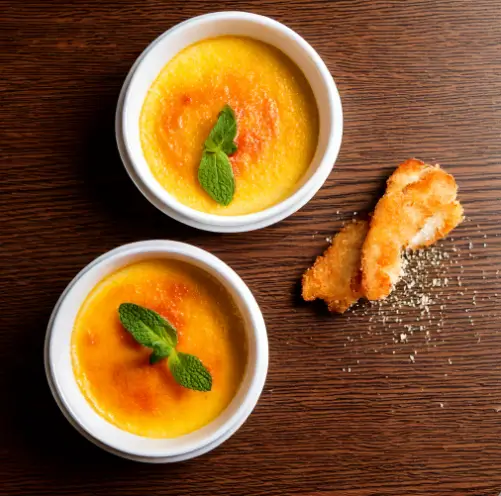Introduction
Crème brûlée, a dessert that perfectly balances sophistication and simplicity, has captivated dessert enthusiasts for generations. Known for its smooth custard base and crunchy caramelized sugar topping, it’s a timeless classic in French cuisine. Moreover, this iconic dish isn’t limited to its sweet origins; variations such as the crab brulee recipe offer an innovative savory twist that combines the richness of custard with the delicate sweetness of fresh crab.
Whether you’re a seasoned chef or a novice in the kitchen, mastering crème brûlée is within reach. This guide will not only walk you through the steps to create the perfect dessert but also explore exciting ways to elevate it. By the end, you’ll feel confident crafting both the traditional crème brûlée and its creative variations, impressing your guests and satisfying your culinary curiosity.
What Is Crème Brûlée? Discovering Its Roots and the Crab Brulee Recipe
Crème brûlée, which translates to “burnt cream” in French, is a classic dessert that has truly stood the test of time, captivating generations with its exquisite appeal. Known for its luxuriously rich custard base and its perfectly crisp, caramelized sugar topping, it offers a delightful combination of textures and flavors that few desserts can rival. Furthermore, its inherent simplicity allows the quality of the ingredients to shine through, making it an enduring favorite among professional chefs and home cooks alike. With its elegant appearance and timeless charm, crème brûlée continues to symbolize the perfect marriage of sophistication and comfort in the culinary world.
Although it originated in France, crème brûlée has become a global phenomenon, appreciated for its versatility. Traditionally flavored with vanilla, it can also be infused with a variety of flavors, such as citrus, coffee, or chocolate. More recently, adventurous cooks have embraced savory variations like the crab brulee recipe, which takes this beloved dessert in a completely new and exciting direction.
In addition, crème brûlée is celebrated for its elegance. It’s a dish that feels indulgent yet approachable, making it perfect for special occasions or even a luxurious treat at home. Whether you enjoy it in its classic form or explore creative twists, crème brûlée is a testament to the magic of culinary artistry.
Essential Ingredients for Crème Brûlée and Crab Brulee Recipe
A perfect crème brûlée starts with a short list of essential ingredients, where quality is paramount.
Core Ingredients
- Heavy cream: The base of crème brûlée, lending its luxurious texture.
- Egg yolks: The binding agent, creating the custard’s structure.
- Granulated sugar: Used for sweetness in the custard and for the caramelized topping.
- Vanilla: Adds depth; choose a bean for the most authentic flavor or extract for convenience.
For a Crab Brulee Recipe
The savory counterpart requires additional ingredients:
- Fresh crab meat: The highlight of the dish, offering a delicate yet distinct flavor.
- Chives or green onions: For a touch of freshness and a subtle bite.
- Salt and pepper: To balance the flavors.
- Optional spices: Paprika or cayenne for a hint of heat.
Tips for Ingredient Selection
- Always opt for fresh, high-quality ingredients for the best results.
- If using vanilla extract, ensure it is pure rather than imitation for a more authentic flavor.
- Fresh crab meat is essential for a crab brulee recipe. Avoid canned or frozen varieties when possible, as these can dilute the dish’s flavor.
Step-by-Step Guide to Making the Custard
Creating a custard that is both smooth and flavorful requires attention to detail. Below is a guide to mastering this crucial step:
Classic Crème Brûlée Custard
- Heat the cream: Gently warm heavy cream over medium heat. Do not let it boil, as overheating can alter the texture. If using a vanilla bean, split it lengthwise and add it to the cream for infusion.
- Whisk the yolks and sugar: In a bowl, combine egg yolks and granulated sugar. Whisk until the mixture turns pale and creamy, which ensures a silky custard.
- Temper the eggs: Slowly pour the warm cream into the yolk mixture, whisking constantly. This step prevents the eggs from curdling.
- Strain the custard: Pour the mixture through a fine mesh sieve to remove any lumps or impurities.
Adjustments for Crab Brulee
After straining the custard, mix in the crab meat and seasonings. Fold gently to distribute the ingredients evenly, ensuring the crab flavor is infused without overpowering the custard’s creamy base.
Techniques for Caramelizing the Sugar
The crowning glory of crème brûlée is its caramelized sugar topping. Achieving the perfect crackly surface takes technique and precision.
Step-by-Step Caramelization
- Prepare the surface: Once the custards are chilled, sprinkle an even layer of granulated sugar on top. Use about one teaspoon per ramekin.
- Torching the sugar: Hold a culinary blowtorch a few inches from the sugar. Move it in circular motions to melt and caramelize the sugar evenly. The goal is a golden-brown finish with no burnt spots.
- Cool briefly: Allow the caramel to harden for 1-2 minutes before serving.
Tips for Crab Brulee
For a savory twist, replace the sugar with breadcrumbs or a light sprinkling of Parmesan cheese. Torch these toppings until they turn golden and crisp, complementing the crab custard beneath.
Baking Crème Brûlée and Crab Brulee: Tips for Success
The baking stage determines the custard’s consistency. Follow these guidelines for the best results:
- Use a water bath (bain-marie): Place ramekins in a deep baking dish and fill it with hot water until halfway up the sides. This method ensures even cooking and prevents the custard from cracking.
- Set the oven temperature: Bake at 325°F (160°C) for 30-40 minutes. The edges should be set while the center remains slightly jiggly.
- Cool properly: Remove the ramekins from the water bath and let them cool at room temperature before refrigerating for at least 2 hours.
For a crab brulee recipe, the custard may need slightly longer baking due to the added ingredients. Keep a close eye to avoid overcooking.
Common Mistakes to Avoid
Even seasoned cooks can encounter challenges with crème brûlée. Here’s how to avoid common pitfalls:
- Curdled custard: This happens if the cream is too hot during tempering. Always heat it gently and whisk continuously.
- Uneven caramelization: Use a steady hand and maintain consistent movement when torching the sugar.
- Overcooking: Check the custard frequently. Overbaking results in a rubbery texture instead of a creamy one.
- Improper storage: Keep the custards refrigerated and torch the sugar only before serving to maintain the desired texture.
With a crab brulee recipe, ensure the crab meat is well-drained to avoid watery custard.
Flavor Variations to Try
Crème brûlée is a versatile dessert that adapts well to various flavors.
Sweet Variations
- Chocolate: Stir melted dark chocolate into the custard base.
- Coffee: Add espresso powder for a rich, aromatic twist.
- Citrus: Zest lemons or oranges for a refreshing flavor profile.
Savory Variations
- Crab Brulee: As detailed in this guide, fresh crab meat transforms this dessert into an elegant appetizer.
- Cheese-infused custard: Parmesan or Gruyere can create a decadent savory treat.
- Herb accents: Infuse the cream with rosemary or thyme for a subtle earthy note.
Experimenting with flavors allows you to personalize this classic dessert to suit any occasion.
Serving and Storing Crème Brûlée
How to Serve
- Serve immediately after caramelizing the sugar to enjoy the contrasting textures.
- Accompany with fresh berries or a dollop of whipped cream for added appeal.
- For a crab brulee recipe, garnish with microgreens or a drizzle of lemon-infused olive oil.
Storage Guidelines
- Store prepared custards in the refrigerator for up to 3 days, covered with plastic wrap to prevent moisture loss.
- Avoid caramelizing the sugar until just before serving, as it loses its crunch when refrigerated.
Proper storage ensures your crème brûlée retains its flavor and texture, whether served fresh or saved for later.
Conclusion
In conclusion, crème brûlée is a dessert that beautifully marries elegance with simplicity, making it a beloved choice for both novice cooks and experienced chefs. Its smooth custard base and signature caramelized sugar topping create a sensory experience that’s hard to beat. Whether you stick to the timeless classic or venture into savory territory with recipes like the innovative crab brulee, the versatility of crème brûlée ensures there’s something for everyone.
By mastering the essential techniques—carefully selecting ingredients, perfecting the custard, and achieving that iconic caramelized finish—you can create a dish that not only impresses but also delights. Moreover, exploring flavor variations allows you to push the boundaries of this classic dessert, tailoring it to suit any occasion or personal preference.
Whether served as an indulgent treat at home or a show-stopping course for guests, crème brûlée is a testament to the art of cooking, proving that even the simplest dishes can leave a lasting impression. With this guide in hand, you’re ready to embrace the challenge and joy of crafting crème brûlée in all its delicious forms.
FAQs About Crème Brûlée and Crab Brulee Recipe
1. Can I use milk instead of cream?
Yes, but the custard will lose some of its richness. A mix of cream and milk can balance texture and flavor.
2. Can crème brûlée be made dairy-free?
Substitute heavy cream with coconut cream or almond milk for a dairy-free option.
3. How do I ensure the sugar caramelizes evenly?
Keep the blowtorch moving steadily across the surface. Avoid staying in one spot too long.
4. What’s the best way to enhance a crab brulee recipe?
Fresh crab meat is key. Complement it with herbs and spices to highlight its natural flavor.
5. Can I freeze crème brûlée?
Freezing is not recommended, as it affects the custard’s creamy texture.
Conclusion
In conclusion, crème brûlée is more than just a dessert—it’s a testament to the beauty of simple ingredients transformed through precise techniques. Its iconic caramelized topping and creamy custard make it a dessert that stands out, whether served at a formal gathering or enjoyed as a personal treat.
Additionally, exploring variations like the crab brulee recipe allows you to bring creativity into your kitchen. By incorporating savory elements, you can transform a classic dish into something entirely unique and equally delightful.
If you’ve ever hesitated to make crème brûlée, let this guide serve as your roadmap. With the tips and techniques provided, you’ll confidently create a dessert (or appetizer) that not only satisfies but also amazes. So, gather your ingredients, follow the steps, and enjoy the journey of making this timeless dish.
Explore the pros and cons of using Store-Bought Custard for Crème Brûlée in your recipes

